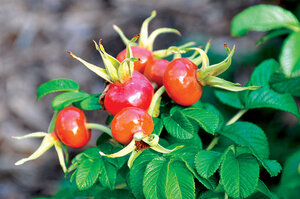Raise unique roses from seed
Unlike starting them from cuttings, results may surprise.

Rose Hips
Lynn Hunt
With few exceptions, the rose varieties we love today began as a single nondescript seed. Every rose (aside from species roses) produces seeds that are unique, because they are the product of two sets of genetic material. And so if you grow the seeds – rather than, say, taking a cutting from a rose plant – no one can say whether the seedling will be a winner or a dud.
Hybridizer Bill Radler had been working for 15 years to develop a new line of disease-resistant, easy-care roses. Little did he know the solitary seed he harvested from a single hip on a straggly rosebush he almost trashed would grow up to be Knock Out. (In case you don’t know, low-maintenance Knock Out shrub roses, introduced in 2000, are now the most widely sold rose in North America, according to the Conard-Pyle Co.)
Professional hybridizers have the edge when it comes to producing a truly special rose. The process is tedious, lengthy, and painstaking. Roses are cross-pollinated, hips (or fruits) are allowed to form, and the resulting seeds are planted and closely observed.
Then comes more crossbreeding, more hips, more seeds, and, for the most part, disappointment.
Every year the folks at David Austin Roses plant approximately 150,000 seeds. After several years, most of the seedlings get the thumbs down for one reason or another (David Austin himself still makes the final decision). In time, perhaps three to five roses from the original planting will make it into commerce. In other words, the possibility of coming up with a keeper is very remote.
How to proceed
Most of us don’t have the expertise or inclination to set up a proper rose hybridizing program, but it’s still fun to plant a few seeds and see what happens. If you stop cutting back spent flowers, the bees will do their thing and hips will begin forming on your bushes. After the hips turn red or orange and are fully ripe, cut them off and bring them inside to harvest the seeds. (If you don’t have hips in your garden, ask a friend or local nursery for a few.)
Carefully cut the hips open with a sharp knife, remove the seeds, wipe them clean, and drop them in a glass of water. Seeds that float won’t germinate as well as those that sink.
Discard the floaters and wrap the remaining seeds in a handful of moist vermiculite or peat moss – even damp paper towels can work. Place them in a zip-lock bag and write the name of the rose plant from which the seeds were harvested (if you know it) on the outside of the bag with an indelible marker.
Seeds need cold temperatures to initiate the germination process, so place the bags in your vegetable crisper for about 60 days. Mark your calendar so you know when to take them out.
There are many ways to plant the seeds once they finish their long winter’s nap. I’ve sown mine under grow lights in cheap plastic shoe boxes with a couple inches of sterile soil. Plant seeds about 1/4 inch below the soil surface.
Make sure indoor temperatures are at least 70 degrees F., and keep the lights on for about 16 hours a day. In areas of the country where spring temperatures are above 70 degrees, you can plant them in flats and set them outside. Whichever method you try, be sure to keep the soil moist, but not dripping wet.
When the seedlings begin to grow, the first two leaves that appear are cotyledons (Greek for “seed leaves”). The next leaf will look like a rose. Amazingly, many of these seedlings will flower in as little as five to six weeks, although some take a full season to bloom.
If you like what you see when it blooms, carefully transplant the new rose into a separate pot. Within three years you should have a fully mature bush and a never-before-seen variety.
It may never achieve Knock Out status, but since you grew it, I promise you will love it.

